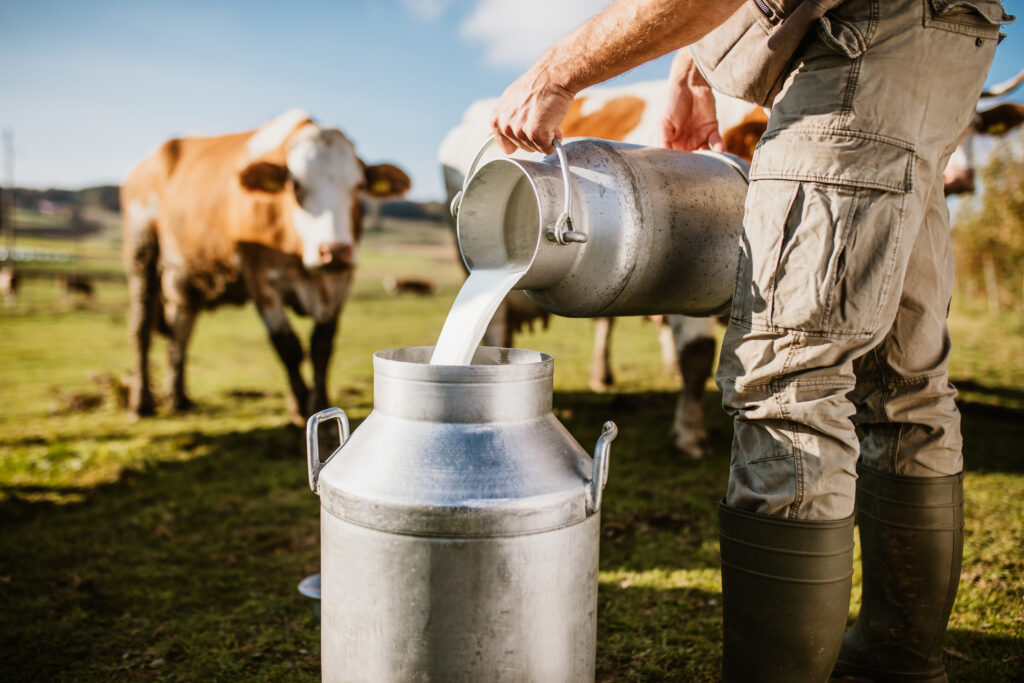A farmworker pours milk into a container. A new Wisconsin agriculture order requires cows to be tested for avian flu before they’re taken to shows or to be displayed. (Getty Images)
No Wisconsin dairy herds have reported an infection with the H5N1 influenza, nicknamed bird flu, but starting later this month farmers will be required to test lactating cows for the virus before taking them to shows or displays.
The Department of Agriculture, Trade and Consumer Protection (DATCP) announced this week it would require the tests starting June 19.
Farm organizations endorsed the requirement Wednesday.
“Wisconsin’s dairy community is committed to protecting cows in our state from the H5N1 virus,” said Tim Trotter, CEO of the Dairy Business Association, in a statement. “Recognizing the need to be as careful as possible, we see the new testing requirement related to fairs and exhibitions as sensible in those efforts.”
“It makes sense to require testing,” said Michelle Ramirez-White, policy coordinator for the Wisconsin Farmers Union. “We think it’s really important to make sure that the commercial milk supply is secured.”
DATCP has posted a webpage on H5N1 in dairy cattle at AvianInfluenzaCattle. [/infobox]
The virus is known as avian flu because it’s normally spread by migratory birds. But in recent months it has turned up in dairy cattle in 12 states, including Iowa, Michigan and Minnesota, which all border Wisconsin.
“We have not seen a case in Wisconsin, but with the busy fair season coming up that’s a concern,” Ramirez-White told the Wisconsin Examiner.
The U.S. Department of Agriculture has already issued a federal order requiring dairy cattle moving across state lines to be tested for the virus.
Nationally three people have been reported to have been infected with the virus, none of them in Wisconsin.
“As Wisconsin does not have any known infected dairy herds at this time, there has been no human testing for the H5 bird flu in Wisconsin,” said Elizabeth Goodsitt, spokesperson for the Wisconsin Department of Health Services (DHS).
In an email message, Goodsitt told the Wisconsin Examiner that DHS is collaborating with DATCP to make personal protective equipment, including coveralls, face shields, vinyl gloves and N-95 respirators, available to dairy and poultry farms, dairy processing plants, slaughterhouses and agencies that support farm or slaughterhouse workers.
DHS has posted a form for PPE requests at the department’s Health Emergency Preparedness and Response Medical Stockpile web page.
Participants in a national public health webinar Wednesday on the recent spread of the H5N1 flu virus to dairy herds and people said that much more data is needed both to understand the current risk and to prepare for the possibility of a pandemic. The webinar was presented by the University of Southern California Center for Health Journalism.
“We don’t know how many people have been infected,” said New York Times health and science reporter Apoorva Mandavilli. “We know of three cases, but only about 45 people have been tested. So there could be many more that we just don’t know about.”
The actual spread to cows is also unknown, she added.
“My highest level of concern right now is for the workers on the farms, who we know are being exposed to this virus and we know are already getting sick with this virus,” said Jennifer Nuzzo, director of the Pandemic Center at the Brown University School of Public Health. “We need to be talking more about protecting the workers who are in harm’s way today.”
Nuzzo said she believes there should be much more widespread testing for the virus, with particular attention to farmworkers and others at high risk. In addition to the three confirmed cases, there have been reports of other people with similar symptoms, she observed.
“So far, the infections that have happened have been mild,” Nuzzo added. “But I do not see anything in the data to give me hope that future infections will necessarily be.”
Dr. Matifadza Hlatshwayo Davis, the director of health for the city of St. Louis, agreed that people who work with animals are among the most at risk, and that focusing on their risk is important.
At the same time she cautioned that the message needs to be clear that risks are different for different groups of people. “I wouldn’t be doing my job, quite frankly, [by being] alarmist about the risk for the general public,” Davis said.
GET THE MORNING HEADLINES DELIVERED TO YOUR INBOX
The post Bird flu worries prompt new testing orders for cows, concern for farmworkers and others at risk appeared first on Wisconsin Examiner.

